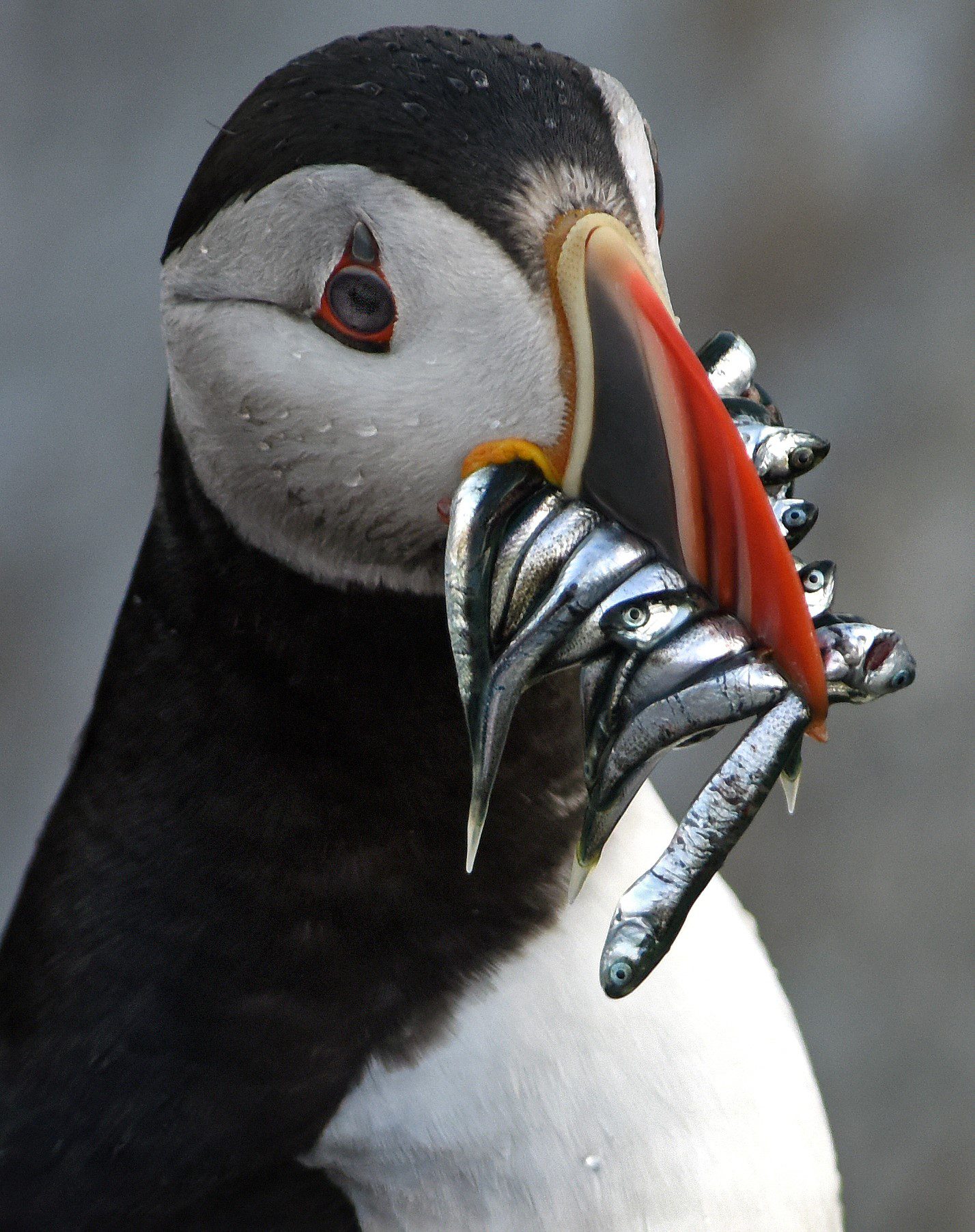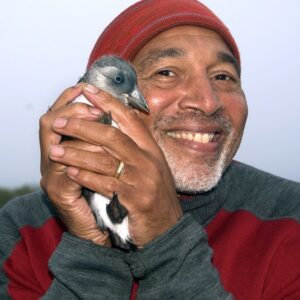A year after climate change delivered a devastating 2021, research teams on islands in the Gulf of Maine all but popped champagne over the comeback of seabirds.
Seal Island’s team wrote, “We are amazed by the resilience of our seabirds, who returned to these shores after a season of starvation in 2021, and have raised gorgeous, sleek chicks in 2022.”
Research assistants on Matinicus Rock wrote, “The decent productivity of 2022 seems like a miracle in the wake (of 2021).” From Pond Island, the team said the summer “highlighted our terns’ resilience to everything the world can throw at them.”

The buoyant mood similarly permeated August’s end-of-season conference call for the Gulf of Maine Seabird Working Group. The group is a collective, composed primarily of state and federal wildlife biologists, and conservation groups that monitor and protect seabirds on islands stretching from Cape Cod to Nova Scotia.
On Canadian-managed Machias Seal Island, researchers talked of “a great summer,” with “fat and happy” puffins, terns, razorbills and common murres. North Brother Island in Nova Scotia boasted of the highest tern nest count in 30 years.
In Downeast Maine, Petit Manan island recorded 96 active puffin burrows, close to the high of 104 in 2009, hatching out more than 70 chicks. The crew of Ship Island banded a record 1,045 common tern chicks. Off Maine’s midcoast, Metinic Island counted the most terns ever. Outer Green Island in Casco Bay racked up a record number of common terns. The White and Seavey Islands off New Hampshire had their highest common and roseate tern productivity (the number of chicks fledged per nest) since 2016. South Monomoy Island off Cape Cod saw its common tern numbers soar from 12,600 in 2019 to more than 17,000.

The news from the islands was among the best I’ve heard in many years of covering them for newspapers and magazines, and as a photographer and co-author of two books on the restoration of Atlantic puffins with Steve Kress, the founding ornithologist of National Audubon’s Project Puffin. In 2019, the working group estimated there were 27,500 breeding pairs of common terns in the Gulf of Maine. Based on the reports, the number may have made a leap toward 30,000 pairs.
“It’s as if the birds came back with a vengeance,” said Dallas Jordan, who with Becky Howell managed Pond Island for National Audubon’s Seabird Institute and the Maine Coastal Islands National Wildlife Refuge. Last year, Pond was one of the hardest-hit islands in the Gulf of Maine. Not only did its bird colony wither and shiver under record heat and record rain associated with climate change, half of the terns abandoned the island when a great horned owl and a peregrine falcon descended to gobble up birds.
This summer there was no owl, no falcon and no catastrophic weather. The colony rebounded from 700 common tern nests to a record 1,580.
“You can’t overstate what that all means,” Jordan said. “It’s amazing to see the birds come back. But when you look at the big picture, we’ve entered a cycle where the birds can’t rely on anything anymore. They’ve evolved for thousands of years to be accustomed to reliable sites. They’re long-lived birds, so they can handle a bad year here and there. The question is what happens with more bad years.”
Howell chimed in, “Will it be a ticking time bomb?”

For a precious, beautiful summer, the bomb of climate change was defused. The good news from nearly every island was a salve for last year’s funereal reports of record-low or near record-low tern, puffin and razorbill productivity. Last year brought the warmest average surface water temperatures recorded in the Gulf of Maine. The Gulf of Maine Research Institute said the average of 54.1 degrees Fahrenheit marked the first time temperatures were more than four degrees above the historical average.
A four-degree difference is barely perceptible to humans. But for the cold-water fish that North Atlantic seabirds feed their chicks — such as hake, herring, haddock and sand lance — the difference might as well be between Bar Harbor and the Florida Keys. Ocean heatwaves force those fish into cooler water too deep or too far out for puffins and terns to find. Between starvation and hypothermia from soaking rains, the landscape was carpeted with bird carcasses. In a January essay for Grist, I described the islands as a battlefield of climate change.
This summer I visited five islands — Eastern Egg Rock, Matinicus Rock, Pond Island, Stratton Island and Petit Manan Island. The crews were as happy as a United Nations peacekeeping team over nature’s truce of relatively fair weather and water temperatures that did not make fish flee. On some islands, puffins and terns brought nearly foot-long Atlantic saury to their chicks. It was quite a sight to see a saury dangle from the beak of a flying puffin; the length of the fish matched the 10-to-11-inch average height of a puffin.
On Petit Manan, I watched terns suck down sauries twice their length, and puffin chicks in their burrows likewise did not seem to have a problem getting them down. Steve Kress, the retired founder of National Audubon’s Project Puffin, called the saury “the surprise for this year,” an example of why he remains “in awe” about the adaptability of puffins to take advantage of whatever fish are out there.
Even the avian flu that took out thousands of seabirds in colonies in Europe and other parts of North America caused only modest mortality in the Gulf of Maine.
“The quality of the birds, their weight, their feathers and their bones, are just so much better this year compared to last,” said Michael Rickershauser, the Seabird Institute’s supervisor of Stratton Island, in Saco Bay. Kay Garlick-Ott, a former island supervisor for the Seabird Institute who was on Stratton running a graduate school experiment on tern aggression, said simply holding a healthy chick was a privilege. Four years ago, during a debilitating heat wave for the birds, she described the creepy feeling of holding chicks that were so undernourished, she could not feel bones.

On Matinicus Rock, the crew of Tracey Faber, Emily Onderbeke, Molly Henling, Ayla Liss, Will Kennerley and Keenan Yakola led me to the burrow where a 33-year-old puffin was raising a chick. The senior bird is one of the last-known birds that was part of the original Project Puffin. In 1973, National Audubon’s Steve Kress began bringing hundreds of puffin chicks from Newfoundland to Maine islands, where the bird was exterminated in the 1880s. The 33-year-old bird was brought down from Newfoundland in 1989 and raised on Seal Island, nine miles northeast of Matinicus Rock.
“To hold a bird that’s lived for decades and is older than any of us is pretty incredible,” said Yakola, 29. “I know from the records who hand-reared it and it’s seen so much in its time.”

Yakola, an Oregon State graduate student, is continuing to find out how much the birds see in real time. He was on Matinicus Rock to put GPS tags on Leach’s storm petrels to see how far they travel to seek food for chicks. On one trip this summer, the bird, the size of a goldfinch, disappeared for four days to forage for its chick. It traveled 1,400 miles from its home off midcoast Maine. One stop included the Northeast Canyons and Seamounts National Marine Monument, 130 miles southeast of Cape Cod and at the latitude of Philadelphia.
“Storm petrels don’t get much attention,” Yakola said, “but with every bit of information like this that we get, the more we realize how these vast ocean systems are interconnected.”
On Eastern Egg Rock, the island where Project Puffin began, the crew of supervisor Keara Nelson, and assistants Meg Getzinger, Daniel Rubianto and Liv Ridley, were aglow with the highest count of common tern nests in 20 years, and the number of active puffin burrows rising from 140 last year to 171. The record is 188 burrows in 2019. Where Maine was down to a pair of puffins on Matinicus Rock in 1902 because of hunting, today there are more than 1,300 pairs across islands managed by Audubon and the U.S. Fish and Wildlife Service. Machias Seal Island had 8,600 breeding pairs as of its last 2019 census.

In a long afternoon interview, the Egg Rock crew hoped the momentary reprieve inspires society to curb the climate change that threatens to slam these islands beyond anything the birds have experienced. As a small reminder of the roller coaster that the birds are now on, a heat wave toward the end of this season resulted in renewed difficulty for parents to find food for chicks that hatched late. The Matinicus Rock, Egg Rock and Petit Manan crews reported a troubling drop-off in weight of chicks and discovered the bodies of a few chicks that died of starvation.
Noting the threats and tour boats that carry thousands of people around the rock every summer, Nelson said, “This isn’t like a zoo. This is the real world. The animals are not separated from whatever we do at home.”
Rubianto added, “We know we can’t just shut off climate change at this point. We can’t save every bird. But we can save some.” Ridley concurred, citing youth climate activist Greta Thunberg. “She said she doesn’t want people to be just hopeful,” Ridley said. “We need action and getting powerful people to take action.”
Getzinger, 23, said, “There’s something about the fact that these birds can live so long that should make us act as if they really have homes like humans. When I handle the birds, band them and let them go, I treasure the moment and wonder if they’ll come back.”
What the birds come back to depends on whether people decide that a calm summer buys time to take the warming waters seriously, or whether it merely inspires a complacency that guarantees the next calamity.








